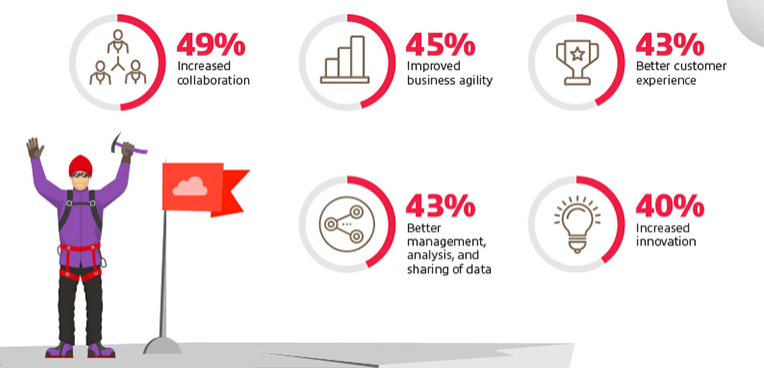Article The Go-to-Mars Mentality: 3 Reasons to Think Bigger for the Future Workforce
By Insight Editor / 25 Jul 2017 / Topics: Modern workplace
By Insight Editor / 25 Jul 2017 / Topics: Modern workplace

The above powerhouse of visionaries have sent a message to businesses in all industries — not just the ones investing in space programs. This is about the big picture of how businesses think. It’s not about the processes, tools or means to become extraordinary. It’s about the mindset of trailblazing to a place that’s foreign, relative to what you know today. It’s about the call to have a “go-to-Mars" mentality — a call today’s businesses must answer to stay alive amid the digital workforce revolution.
A transformational mindset can benefit businesses in significant ways, but the biggest long-term win lies within empowering workers who are on the front lines — with the right tools to build bottom lines. In a world of digitally savvy, on-the-move workers, businesses that aren’t keeping end users happy are seeing fading morale, high turnover rates, a tarnished brand image and more internal resources going to reactive IT firefighting instead of digital transformation.
Here are three reasons why now is the perfect time for organizations to adopt this type of future-focused thinking.
When we examine workforce statistics from the past two years alone, it becomes clear the workforce is primed for disruptive technologies. Businesses need to innovate in significant ways to attract and retain new-age workers.

Figure 1 shows engagement levels based on time spent working away from the office, according to a Gallup poll. The most engaged group spends 60–80% of the time (three to four days during the work week) working remotely.
Here’s a breakdown of other significant findings:
Businesses can no longer afford to delay transformation. And with the rise of the Gen Z workforce — the post-Millennial generation made up of true digital natives — it will become imperative to think ahead as they dominate the workforce population.
Insight Microsoft Services Practice Lead John Murphy exemplifies a “go-to-Mars" mentality. With enthusiasm, he states, “The future office — on Earth, on Mars or anywhere in the galaxy, needs only three things to work: a device, an email address and an internet connection. That’s it.”
Think about the same simplicity when delivering a superior Out-of-Box Experience (OOBE), the initial setup experience when a user prepares to use a new device for the first time. More organizations are investing in their own OOBE, citing benefits such as positive perception of the business and reduced long-term costs. If users gets lost in a frustrating maze of licensing agreements, installation wizards and an abundance of steps during the setup process, they’re likely to lose trust in the brand that delivered it to them, dubbing the instance as a dreaded “out-of-box failure.”
“At the end of the day, today’s workers are also consumers,” adds Murphy. “They expect the same intuitive digital experience inside and outside of the office, so businesses should aim to deliver devices and applications that require the least amount of effort from the end user.”
Modern work devices powered by Windows 10, for example, prompt users to turn on the device and enter an email address that’s connected to the cloud — a minimal-step process to get up and running. Solutions such as the Apple Device Enrollment Program eliminate initial setup altogether through zero-touch configuration on the back end. Innovating the OOBE is what tomorrow’s industry leaders will deliver to their ever-moving, digital workforce.
So how do these experiences come to life? What enables a superb OOBE? And, more importantly, what sustains the seamlessness when a device is in use? Businesses should look to the cloud.
According to the 2017 Insight Intelligent Technology Index, IT pros report more flexibility and collaboration as a result of cloud migration — two things that, coincidentally, a thriving workforce requires. But, with security concerns around the cloud, many businesses are struggling to adopt "go-to-Mars" mentalities of their own. This is a matter of mysticism, both culturally and technically, around the cloud. In reality, these once-hot-button concerns are now largely dispelled myths. And with the number of businesses in the cloud already in the thousands, Microsoft continues to invest more than $1 billion a year on their own research and development around security to prevent costly breaches.

Figure 2 shows findings from Insight’s 2017 Intelligent Technology Index. Increased collaboration (49%), agility (45%), innovation (40%) and more are cited as top benefits of cloud migration.
Businesses that have gotten past the myths surrounding the cloud have invested in these technologies and now have a leg up in the race to innovate. According to Microsoft’s vice president of security, Bharat Shah, Microsoft saw a quarterly increase of 116% in Azure sales last October, a sign that cloud adoption trends are rising.
But the decision to jump-start workplace transformation through the cloud should hinge on several key deal breakers: true, single-platform unification, seamless integration, proper workload migration, automated provisioning and effective encryption methods — all from trustworthy cloud vendors with proven track records. These standards not only ensure solid security and a better end-user experience, but they also address the common business challenge of freeing IT resources to focus on innovation rather than back-end systems.
Dominating in today’s work environment requires a mindset focused on the future, even if it seems impossible right now. At Insight, we believe businesses are now in a prime position to begin challenging their status quos to reach beyond legacy systems and mindsets — even beyond the planet, if need be.
After all, it's hard not to be inspired by leaders of the most powerful brands in the world.

Discover reports, stories and industry trends to help you innovate for the future.